The WiFi Extenders Market is estimated to be valued at USD 2.1 billion in 2025 and is projected to reach USD 5.5 billion by 2035, registering a compound annual growth rate (CAGR) of 10.0% over the forecast period.
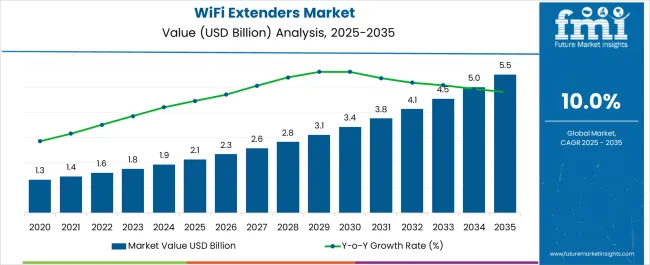
| Metric | Value |
|---|---|
| WiFi Extenders Market Estimated Value in (2025 E) | USD 2.1 billion |
| WiFi Extenders Market Forecast Value in (2035 F) | USD 5.5 billion |
| Forecast CAGR (2025 to 2035) | 10.0% |
The WiFi extenders market is advancing steadily, fueled by the rising demand for seamless connectivity across residential and commercial spaces. The proliferation of smart devices, streaming services, and remote working models has significantly increased bandwidth requirements, creating a need for efficient solutions to eliminate dead zones and enhance coverage.
Technology firms have emphasized innovation in dual-band and mesh-based extenders, with product launches focusing on higher data throughput and compatibility with next-generation WiFi standards. Consumer electronics reports and corporate earnings briefings have noted strong adoption in urban households, where dense network environments require stable connections.
Additionally, the integration of IoT devices into everyday life has amplified the need for reliable WiFi coverage, further boosting market demand. Future growth is expected to be driven by rapid digitization in emerging markets, increasing adoption of cloud-based applications, and ongoing upgrades to smart home ecosystems. Market expansion is anticipated to remain anchored in residential use, with dual-band extenders maintaining technological leadership due to their balance of affordability and performance.
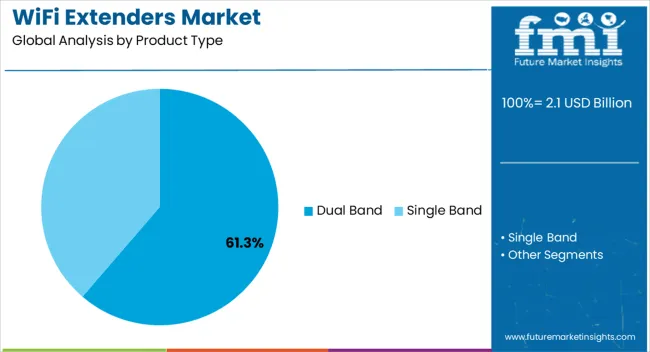
The Dual Band segment is projected to account for 61.3% of the WiFi extenders market revenue in 2025, positioning itself as the leading product type. Growth in this segment has been supported by its ability to provide stable connectivity by operating on both 2.4 GHz and 5 GHz frequency bands.
Consumers have preferred dual-band extenders due to their capability to reduce interference and enhance performance for bandwidth-intensive applications such as video conferencing, gaming, and streaming. Product announcements from networking companies have highlighted dual-band solutions as cost-effective alternatives to tri-band or mesh systems, ensuring wider accessibility for residential users.
Additionally, dual-band extenders have been integrated with smart management features such as automatic band steering and app-based controls, improving user experience and adoption rates. With the balance between affordability, compatibility, and performance, the Dual Band segment is expected to remain the dominant choice among consumers seeking effective WiFi coverage solutions.
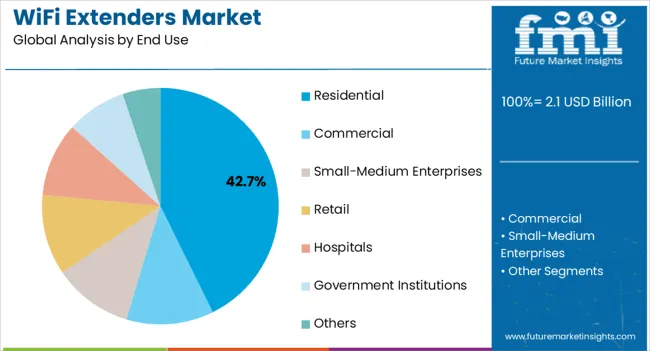
The Residential segment is projected to hold 42.7% of the WiFi extenders market revenue in 2025, sustaining its lead over other end-use categories. Demand in this segment has been reinforced by the rapid expansion of connected home devices, including smart TVs, speakers, appliances, and security systems, all of which require uninterrupted internet access.
The surge in remote working and e-learning has further emphasized the need for strong WiFi signals throughout households. Residential consumers have increasingly invested in extenders to address connectivity challenges in multi-story houses and densely populated neighborhoods where interference is common.
Press releases from consumer electronics manufacturers have indicated that residential adoption is further driven by simplified installation processes and improved affordability of devices. The rise of smart home ecosystems and growing reliance on continuous connectivity across various household activities are expected to ensure the Residential segment’s sustained leadership in the WiFi extenders market.
The need for public WiFi networks has increased, particularly for the management of infrastructure, traffic, safety, and waste and water, and the same is likely to spike the sales of WiFi extenders to a considerable extent. The WiFi extenders market key trends & opportunities are primarily fostered by the telecommunications sector's increased adoption of LTE technology.
The rising demand for WiFi extenders is also due to the fact that WiFi extenders greatly aid in offices or homes where there is one main wireless connection that needs to cover a wider coverage area than the capacity of the main router.
Increasing efforts from service providers and device vendors to eliminate problems such as poor signal quality and slow internet speeds are also expected to augur well for the WiFi extenders market future trends. There is a surge in the sales of WiFi extenders among people living in high-rises, as the buildings are closely packed, and most residents do not get a proper network.
Consumer electronics, safety, and defense industries have experienced rapid growth and development, setting the stage for new business opportunities, in turn, this is positively impacting the WiFi Extenders market trends and forecast. According to the WiFi Extenders market survey, growing public awareness of various technological advancements is a major factor influencing the demand for WiFi extenders.
The WiFi extenders market size expansion is largely due to rapidly evolving WiFi Extenders market trends and consumer preferences, including customization and testing services tailored to specific industries. The market for WiFi extenders is also growing significantly due to the rising demand for cloud computing services and applications.
Challenges that are hampering the deployment of WiFi extenders on a broad scale include low awareness, high device and installation costs, and limitations of these devices in increasing Internet throughput from public hotspots.
The inability of these devices to amplify a signal from a distant Internet source to create a wireless hotspot effectively is also expected to impede the WiFi Extenders market growth.
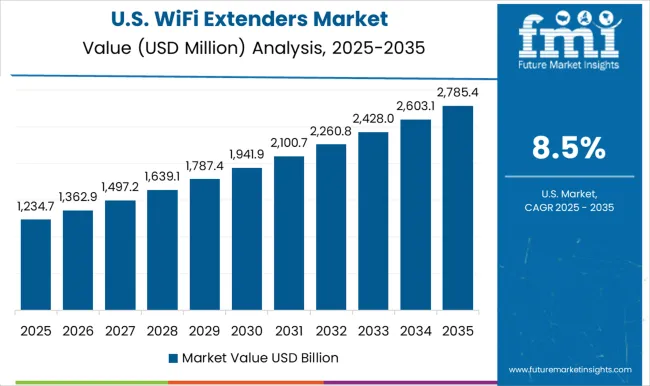
The market for WiFi extenders has advanced in the North American region because of the telecommunications and network sector's expansion and the emergence of regional players. The WiFi extenders market in the United States is steadily growing, contributing to North America’s anticipated WiFi extenders market share of 37% in 2025.
The majority of the major manufacturers of WiFi range extenders have their corporate headquarters in the region. Prior to a global launch and deployment of the product, the majority of businesses test and introduce their goods locally, pushing forward the region’s market growth.
North America’s WiFi extenders market statistics are expected to get on a higher trajectory due to the rising number of devices per household, quick adoption of new technology, and growing emphasis on digitalization.
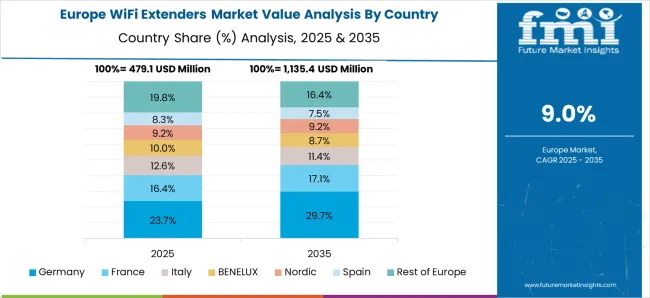
Europe is likely to acquire a WiFi extenders market share of 21% as of 2025, owing to the soaring sales of WiFi extenders in the European region being fuelled by technological developments and a growing consumer electronics market.
One of the market's top players, Tesla, has introduced the Smart WiFi booster Gen 3 that is intended for remote workers. The WiFi 6 technology used in the booster's construction was entirely made of recycled plastic.
This factor has raised the product's value throughout Europe and in other nations where there are restrictions on the use of plastics, in turn, eliciting emerging trends in the WiFi extenders market.
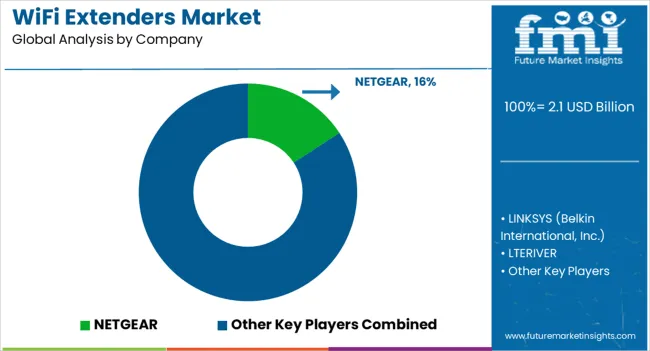
Key players operating in the global WiFi extenders market are NETGEAR, LINKSYS (Belkin International, Inc.), LTERIVER, D-Link Corporation, TP-Link Technologies Co., Ltd, Amped Wireless, Zyxel Communications Corp and Hawking Technologies, Inc., Lutron Electronics Co., Inc., Asustec Computer Inc.
With the concept of WiFi extender being both evolutionary and of sufficient value, an increasing number of vendors are expected to bring about emerging trends in the WiFi extenders market.
| Report Attribute | Details |
|---|---|
| Growth Rate | CAGR of 10.0% from 2025 to 2035 |
| WiFi Extenders Market Value (2025) | USD 2.1 billion |
| WiFi Extenders Market Anticipated Forecast Value (2035) | USD 5.5 billion |
| Base Year for Estimation | 2025 |
| Historical Data | 2020 to 2025 |
| Forecast Period | 2025 to 2035 |
| Quantitative Units | Revenue in USD million and CAGR from 2025 to 2035 |
| Report Coverage | Revenue Forecast, Volume Forecast, Company Ranking, Competitive Landscape, Growth Factors, Trends and Pricing Analysis |
| Segments Covered |
Product Type, End Use, Region |
| Regions Covered |
North America; Latin America; Western Europe; Eastern Europe; South Asia & Pacific; East Asia; Middle East & Africa |
| Key Countries Profiled | United States, Canada, Brazil, Mexico, Germany, United Kingdom, France, Spain, Italy, Poland, Russia, Czech Republic, Romania, India, Bangladesh, Australia, New Zealand, China, Japan, South Korea, GCC Countries, South Africa, Israel |
| Key Companies Profiled |
NETGEAR; LINKSYS (Belkin International Inc.); LTERIVER; D-Link Corporation; TP-Link Technologies Co., Ltd.; Amped Wireless; Zyxel Communications Corp.; Hawking Technologies Inc.; Lutron Electronics Co. Inc.; Asustec Computer Inc. |
| Customization & Pricing | Available upon Request |
The global WiFi extenders market is estimated to be valued at USD 2.1 billion in 2025.
The market size for the WiFi extenders market is projected to reach USD 5.5 billion by 2035.
The WiFi extenders market is expected to grow at a 10.0% CAGR between 2025 and 2035.
The key product types in WiFi extenders market are dual band and single band.
In terms of end use, residential segment to command 42.7% share in the WiFi extenders market in 2025.






Full Research Suite comprises of:
Market outlook & trends analysis
Interviews & case studies
Strategic recommendations
Vendor profiles & capabilities analysis
5-year forecasts
8 regions and 60+ country-level data splits
Market segment data splits
12 months of continuous data updates
DELIVERED AS:
PDF EXCEL ONLINE
WiFi Alarm System Market Size and Share Forecast Outlook 2025 to 2035
WiFi as a Service Market Size and Share Forecast Outlook 2025 to 2035
Fillers & Extenders Market Size and Share Forecast Outlook 2025 to 2035
Demand for Alternative Protein Meat Extenders with Shelf-life Control in CIS Size and Share Forecast Outlook 2025 to 2035

Thank you!
You will receive an email from our Business Development Manager. Please be sure to check your SPAM/JUNK folder too.
Chat With
MaRIA